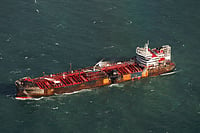The 22-foot-long sea vessel, Titan, with five passengers onboard perhaps has less than 10 hours of oxygen creating a race-against-time-like situation for authorities to locate the submersible. After detecting loud 'banging noises' for the second day in a row, rescuers on Wednesday (local time) rushed more ships and vessels to the area where the sub disappeared on its way to the Titanic wreckage site, hoping that the underwater sounds might help narrow their search in an increasingly urgent mission. Meanwhile, newly uncovered allegations suggest significant warnings were made about vessel safety during the submersible’s development.
The search operation led by the US Coast Guard is concentrating on a remote area in the North Atlantic Ocean after it vanished in the same place on Sunday. The search operation has been growing "exponentially" with a team of French specialists on remotely operated vehicles (ROVs) and more ships and underwater vessels were joining the search.
Although the banging noises were heard from its last location for two days, raising hope among the rescue teams and authorities, it has not been ensured whether the noises originated from the vessel.
However, holding on to hope
Crews were scouring an area twice the size of Connecticut in waters two-and-a-half miles deep, said Captain Jamie Frederick of the First Coast Guard District, who noted that authorities are still holding out hope of saving the five passengers onboard the Titan.
But even those who expressed optimism warned that many obstacles remain -- from pinpointing the vessel’s location to reaching it with rescue equipment to bringing it to the surface -- assuming it’s still intact. And all that has to happen before the passengers’ oxygen supply runs out, which some have estimated might happen as early as Thursday morning, according to a report by AP.
Cold conditions, lack of oxygen
Dr Ken Ledez, a hyperbaric medicine expert at Memorial University in St John's, Newfoundland, has told BBC News that running out of air is not the only danger those on board face. The vessel may have also lost the electrical power that is responsible for regulating the oxygen and carbon dioxide inside the sub.
The lack of oxygen and further building up of CO2 inside the sub may cause people to develop hypercapnia, that is excessive carbon dioxide in the bloodstream. The condition can kill them if not treated. A video of the inside of the Titan also shows that the sub has no system of removing excess carbon dioxide, raising further fear.
The passengers will be struggling in cramped conditions, with no 'door' to get in and out of the vessel, reported the Daily Mail. The sub has no seats and a bathroom that is a black box separated by a black curtain. Reports estimate that if the people onboard survive the cold-like situation, they would be found sitting on the floor, barefoot. Due to extreme cold conditions, they can also develop hypothermia.
The area of the North Atlantic where the Titan went missing is prone to fog and stormy conditions, making it an extremely challenging environment to conduct a search-and-rescue mission, said Donald Murphy, an oceanographer who served as chief scientist of the Coast Guard’s International Ice Patrol. The lost submersible could be as deep as about 12,500 feet (3,800 meters) below the surface near the watery tomb of the Titanic.
Titan’s passengers were likely enduring extremely difficult conditions, including temperatures just above freezing, said Jeff Karson, a professor emeritus of earth and environmental sciences at Syracuse University.
“I am sure it is horrible down there,” Karson said. “It is like being in a snow cave and hypothermia is a real danger.”
CEO and founder of OceanGate Expeditions Stockton Rush, British billionaire explorer Hamish Harding, renowned French diver Paul-Henri Nargeolet and Pakistani businessman Shahzada Dawood and his 19-year-old son Suleman Dawood are on the OceanGate Expeditions’ submersible, Titan.
(with AP inputs)


























